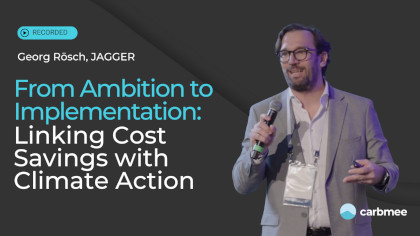Cost savings and climate action. Two themes that at first glance don’t sit very well together. And the challenge for us all as a global community is huge. Despite all the investment in renewables, more than 80 percent of energy consumption is attributable to fossil fuels. And it is those of us in the richer countries (i.e., highest per capita income) that are responsible for the highest carbon emissions per capita: In the USA 13.8 metric tons per person and in the European Union 5.66 metric tons per person. By comparison, in India the figure is just 2.5 metric tons. In 2019, the Least Developed Countries (LDCs) accounted for just 1.1% of total global CO₂ emissions from fossil fuel combustion and industrial processes. On a per capita basis, emissions in LDCs were approximately 9% of the global average. Despite our efforts as individuals to consume “responsibly” in the richer countries—and per capita emissions have fallen in recent years—it is prosperity and economic growth that drive adverse climate change.
I am not making a moral judgement here. Many of us want action on the climate and so do our political leaders, at least here in the European Union. Elsewhere, there are other priorities. In the United States they have voted for a change in direction, and this will have an impact around the world.
Broader geopolitical factors must also be considered. China is notorious for being the largest emitter of CO2; it continues to build coal-fired power stations and nuclear power plants because the country has no oil and little gas. But what is less well known is that China also invests far more than the EU or the USA in its renewable energy capacity as it seeks to reduce its dependency on oil imports. So, whereas the EU is adding 80 Gigawatts in renewable energy capacity per year, China is currently adding around 370 Gigawatts capacity per year.
Of course, the political systems in each country influence what can and cannot be done. In China, without meaningful election cycles, the political leadership can more easily take decisions for the medium and long term.
Procurement has changed
But how does all this affect us in the procurement community?
Procurement today has three overarching objectives: to maximize profitability, minimize risk, and optimize sustainability. The first of these has always been with us. We want to reduce costs. The second has become more pronounced in recent years, notably with the Covid pandemic and supply chain disruptions. Sustainability by contrast has shot up the procurement agenda because what we buy and consume as businesses has the biggest impact on our carbon footprint.
Let’s now break that down into the various stages in the traditional upstream source-to-contract (S2C) processes. At each stage we can build capabilities in support of sustainability and risk management alongside the traditional focus on cost.
First, we can enrich our spend analytics with ESG-related information such as greenhouse gas emissions and risk-related information such as risk per country.
You can then use the insights gained in spend analytics to help define your category and sourcing strategies, for example to give more weight to carbon-neutrality in the electrical energy category.
Based on these strategy decisions you may then want to adjust supplier management, for example by phasing out some suppliers and introducing new ones. You will certainly be enriching your data on each supplier with up-to-date non-financial information.
This non-financial information, together with what you decided in your category management strategy, will help determine your sourcing decisions, enabling you to base them on total value of ownership as opposed to commercial factors alone. You can factor in ESG certifications and risk assessments when choosing between two suppliers whose pricing is equivalent or equal. You may also put in place policies that block the sending of RFPs to suppliers that do not meet non-financial criteria such as having completed sustainability audits. By building this intelligence into sourcing decisions procurement can, moreover, exercise considerable influence over other aspects of the business, such as collaborative R&D projects with suppliers to reduce carbon footprint on joint operations.
Finally contracts management puts the collaboration between buyers and sellers on a firm legal basis.. When contracts management is automated you can reduce manual effort and errors of omission for both teams by automatically re-using legal clauses to ensure compliance.
All this information is then available to buyers in the downstream or procure-to-pay (P2P) half of the procurement process.
ESG data feeds
Some of the data you need to drive decisions based on financial, risk and ESG criteria already exist within your organization but a lot of it needs to be imported from external data feeds. For up-to-date information on carbon emissions JAGGAER works with carbmee. A direct integration allows customers to access data on supplier emissions so that these can be compared during live sourcing events.
By combining JAGGAER with carbmee, you can measure and communicate the carbon footprint of your products, understand your Scope 3 (externally generated) emissions to identify hotspots and make reduction plans, and gain carbon transparency across Scope1, 2 and 3 emissions to report on sustainability and drive your net zero strategy.
This article summarizes a presentation I made at the carbmee Decarbonization Forum 2025, which is available here.





